Tamarix
Today we will talk about a unique plant, which seems to be specially created by nature for decoration - about tamarisk. Perhaps it is hardly possible to pass by him indifferently during the flowering period - so he beckons the eye with its beauty and grace. Growing tamarisk, like any other plant, requires compliance with certain rules of planting, care and reproduction.

What is a tamariks?
Tamarix is a small tree shrub, reaching a height of, as a rule, 1.5 meters. However, there are some species up to 4 meters high. The name of the plant received from the name of the river Tama-Riz (now the river Timbra in the Pyrenees). In the people, tamariks are also called the comb-dresser, the tree of God. To date, there are about 75 species of tamariks, many of which also have healing properties.
Tamarix is notable for its amazing attractiveness and refinement: its thin branches, similar to twigs, are covered with small bluish leaves, and miniature flowers are collected in large inflorescences. Flowers that have not yet opened, on the branches look like small balls of glass beads. For this property tamariks received another name - bead.
Features of tamarisk
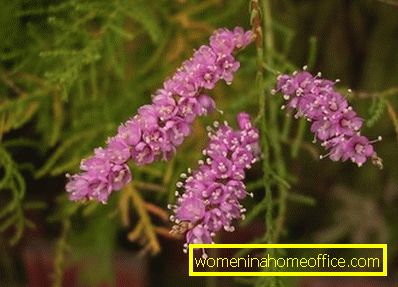
Tamarix is a very picky plant that feels great on dry, saline and clay soils, likes dry soil, but stagnant water and excessive watering have a detrimental effect on its condition. Also the combler is light-requiring and dies even with a slight shade.
This plant tolerates a haircut, transplant, propagated by seeds and cuttings. Bead has a very branched root system that spreads around the plant, forming a network. It is for this reason that today tamariksy is one of the best rocks not only for decorating the landscape, but also for strengthening loose sand.
This tree shrub is amazing also because all its species are extremely easy to interbreed with each other, forming a large number of transitional forms in the color, structure of flowers.
One can talk about the wonderful properties of tamarix for a long time. Let us try to summarize all the advantages of this plant, thanks to which it deserves the attention of gardeners:
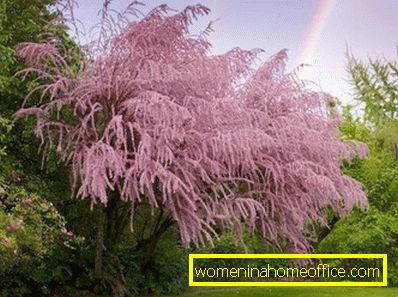
- beauty of the shrub, pleasing the eye for a long time due to a long flowering period (from June to September);
- unpretentiousness of the plant in the choice of soil;
- frost resistance: tamariks perfectly tolerates temperatures up to -28 degrees and does not require special insulation for the winter period;
- the healing properties of the plant;
- variety of species: each gardener will be able to choose the appropriate type for the design of the garden plot.
Variety of shrub species
As mentioned earlier, tamarix has more than 75 species, only 4 of them are widely distributed in our country:
- Tamarix branched - the most common type of ridge dressers, which is mainly planted as a hedge. Quite often found in southern Russia, well adapted to salty soils and strong winds. The disadvantage of this type is that it does not tolerate low temperatures.

- Tamariks chetyrehtychinkovy - very beautiful ornamental shrub with inflorescences of white or pink color and bright emerald foliage.

- Tamarix Meier is a plant species best suited for living in the southern regions, as it does not tolerate severe frosts. It is adapted to drought and winds, it grows well in saline soil. This shrub has long brushes of white or pink color.
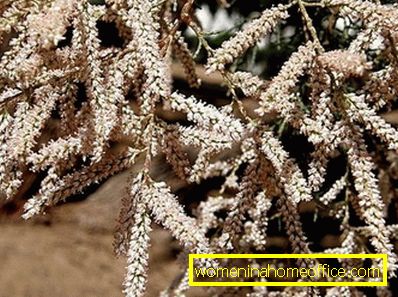
- Tamarix is elegant - an incredibly beautiful view of the plant, although it can be found not so often in garden plots. Compared with the previous species, it has one advantage - quite cold-resistant.
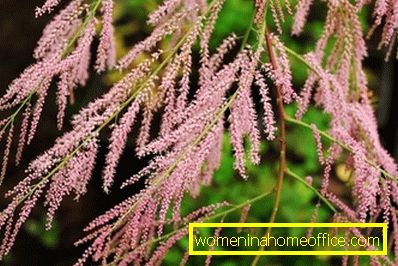
Tamariks: landing and care
In order for your tamarix to quickly take root and delight with its openwork crown, you need to choose the right landing site and follow some simple rules for caring for the plant.
Choosing the perfect place and time for planting
As mentioned above, this plant is absolutely not demanding on the composition of the soil. The only condition is to prevent the stagnation of water. Therefore, before planting in the hole is better to make peat or humus. The ideal place for planting tamarix is open and well lit by the sun hills.
The best time for a transplant is early spring. It is advisable to take young seedlings for these purposes, since old plants take root much worse.
How to ensure proper care for tamarix?
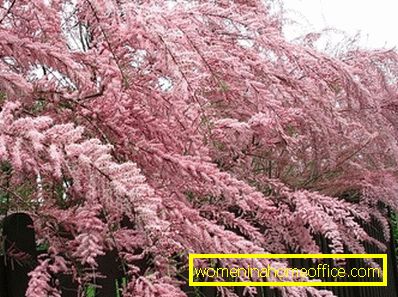
An important factor for the growth of tamarisk - watering, which is necessary for the plant immediately after planting in open ground. When the plant is well rooted, watering should be significantly reduced, that is, produce it only during the dry season.
If the soil is too wet, then dark spots may appear on the shoots of the plant - mold. In this case, the affected areas should be removed immediately, as they can spread to the entire bush.
An important point in the care of tamarix - thinning, removal of old branches. The plant tolerates pruning, and experienced gardeners advise every 5 years to completely cut off the branches of the shrub to the very foundation. In this case, tamariks will be able to grow in one place for decades without losing its attractiveness.
A couple of times for the entire period of flowering the plant should be sprayed with special compounds that prevent the appearance of pests.
Plant propagation methods
There are several ways to breed tamarix:
- seedlings;
- seeds;
- offspring;
- cuttings.
Of course, it is most convenient to propagate the plant with ready-made seedlings, but this requires certain material costs, since they are usually purchased in specialized stores.
Today, reproduction of tamarix cuttings is especially popular, because this way you can grow an entire garden! Make it quite simple, if you follow certain rules.
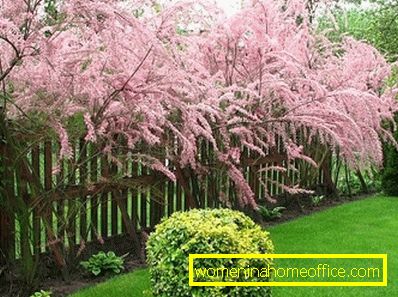
Reproduction tamarix cuttings:
- It is better to cut cuttings in the fall.
- The soil in which you are going to plant prepared cuttings, you must properly loosen and mix with humus or other organic fertilizers.
- Planted cuttings need not very deep (approximate planting depth - 20 cm).
- Before the onset of the cold season, the wells in which the cuttings were planted are best mulched. For mulching, it is usually advised to use peat chips and sawdust.
- In early spring, you can safely transplant cuttings to a "permanent place of residence."
There is another way of breeding tamarix by cuttings: the petiole is placed not in the soil, but in a vessel with water, where it must take root. And only after that they are planted in open ground, as described above.
Tamariks in landscape design

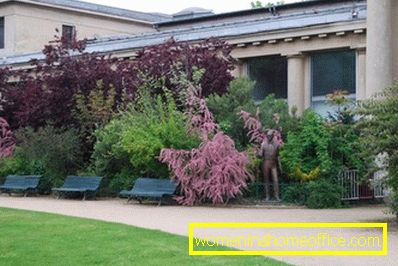

Of course, to design your summer cottage you need to approach with all seriousness, take into account all the details to the smallest detail: familiarize yourself with the peculiarities of shrubs and trees, their flowering period, make sure that they not only look great in your chosen place, but also tolerate the neighborhood of others plants.
Due to its amazing beauty and diversity of species, tamarix is widely used in landscape design to create beautiful hedges or create group plantings. Shrubs bead planted on slopes that need strengthening. Looks great bush on the alpine hills, in combination with low-growing coniferous shrubs, for example, with juniper. In compositions of shrubs, tamarix is better placed on the middle ground next to lilac, barberry, jasmine.
Exquisite tamariks can be planted separately, having decorated the space around it with beautiful decorative stones, or against the background of a lawn. Although, of course, group plantings look more beautiful: on a sunny day, you will have whole placers of beads in your garden, but for these purposes it is better to use tamarix of different types and flowering period.
Today tamariks is widely used for landscaping city streets and squares. This plant seems to be specially created by nature for decoration, because not only its flowers, but also the amazing openwork crown are distinguished by beauty! Perhaps it is difficult to overestimate all the advantages of tamarisk, which is considered one of the most popular ornamental plants.